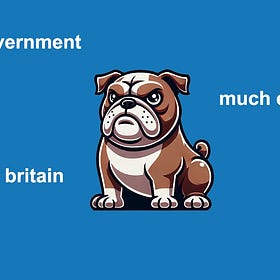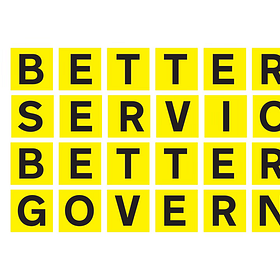Why the new GOV.UK app is a big deal
Catch up with my writing on digital government to learn why it matters
Don’t worry – your regular big essay piece will be along later this week!
POD! On The Abundance Agenda podcast this week, I explain why phone signal on British trains is so bad – and how the French have fixed it. Then Martin digs into the shitstorm at the Office of National Statistics, where it turns out we can’t necessarily trust our numbers. And we speak to Labour MP and the government’s Growth Champion, Dan Tomlinson about the importance of growth to achieving progressive goals. Listen on Apple, Spotify, Substack or wherever you get your pods.
Stop me if you’ve heard this one before.
Today is a big day for the future of British government, as earlier this morning the GOV.UK app hit both of Apple and Google’s app stores.
On the surface, and as some of the dumber headlines are pointing out – it may not feel that important, as the app isn’t yet fully featured. In fact, all it really does is act as an index of links to other pages on the GOV.UK website.
But it matters because the government now has an end-point directly on our phones, heralding a major transition in how citizens and the state interact.
That’s why in this short post today, I’m re-sharing some of my previous writing on digital government, which dives into the deep backstory of why you should care about this.
First of all, here’s the one thing you should definitely read – my deep-dive into the government’s digital “blueprint” – which lays out the long term plan for transforming government, which begins with the GOV.UK app and the OneLogin system it uses.
The new GOV.UK login system is the first step in a radical transformation of the British state
The new “Digital Centre of Government” – which mercifully doesn’t have an acronym that’s a meme – was announced by Technology Secretary Peter Kyle on the 21st January, and on the surface it’s essentially a paper shuffling exercise which pulls together many of the bits of government that do digital stuff, and puts them under the umbrella of a newly beefed-up GDS.1
But what nobody seemed to notice was the startling level of ambition hidden within the plans – that if realised could not just improve how the government does computer stuff, but could remake the British state over here almost as dramatically as DOGE is doing in the United States.
Once you’ve read that, you might like to learn about what this all means in practical terms – and for that, I recommend this piece I wrote recently about Labour Together’s “BritCard” digital ID proposal – and how it would leverage two core components of the GOV.UK app – OneLogin and the Wallet.
The "BritCard" digital ID proposal is a good idea
The GOV.UK Wallet will do something similar to Apple and Google – but will be a place for storing government-issued credentials – which are a key conceptual building block in the government’s ambitious digital plans.
The idea is best described by digital government’s spiritual leader, Richard Pope, in his excellent book Platformland. “Credentials” – or what tech people might call “Tokens” – provide “digital proof that someone has done something.”
And then let’s go even deeper: Here’s my piece on the story of the Government Digital Service (GDS), the revolutionary arm of the British government which made the app – and rebuilt the foundations of how the government does tech. And that’s followed by a piece from my partner, Liz Lutgendorff, who worked at GDS – last year she wrote an amazing piece for me reflecting on her time trying to wrangle creaking old computer systems and bureaucratic processes into something that works in the modern age.
This is the best thing the Tories did in office
In fact, the reason so many government services are now so easy to use is the result of a lot of hard work that began in 2011 with the founding of the Government Digital Service (GDS). It’s an arm of the Cabinet Office, and it was tasked with the mission of redesigning and rebuilding what was then an absolute horror of a government digital estate.
To give you a sense of where it was starting from back when GDS was created, the government didn’t know how many websites it had. This is because government services were fragmented across departments, which in turn had contracted out different digital services to third party providers. They all, invariably, looked more like Geocities than what we have today, and were woefully unprepared for the smartphone era that was then just getting started.
Why fixing government tech is a nightmare (but not impossible)
I spent eleven years at the Government Digital Service, the arm of the Cabinet Office that’s tasked with helping the rest of government modernise and digitise its infrastructure. And what it taught me was that tech proposals that appear elegant and simple on paper often do not survive contact with the messy reality of humans and institutions. And that these institutions create antipatterns that digital services need to defeat.
But luckily, the last twelve years of the government’s digital efforts have not been in vain. In fact, the UK has got a lot to be proud of – but before I tell you why, I need to tell you why making digital government work is so damn hard.
Finally, if you have enjoyed any of the pieces above, or like my work more generally, can I urge you to upgrade to a paid subscription? It’s only with your support that I can continue writing regularly, so if you value my work, your support would be hugely appreciated!








Your comment about institutions being messy is my experience. I was once involved with a project involving bringing together three arms of government under one HR / Payroll system. Each arm insisted on retaining its own expense categories - IIRC this led to “Parking (multi storey)”, “Car Parking (multi storey)” and “Parking (Off Street)”. Login credentials could filter the presented categories, but it made the system work a lot harder than it needed to.